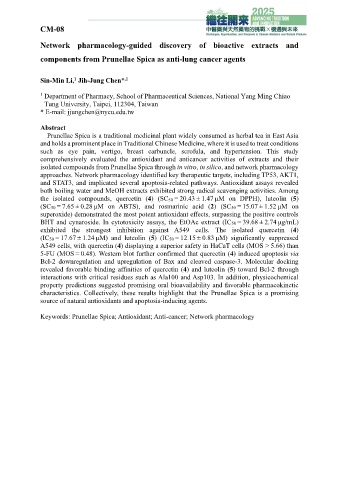Page 275 - 2025中醫藥與天然藥物聯合學術研討會-中醫藥與天然藥物的挑戰X機遇與未來大會手冊
P. 275
CM-08
Network pharmacology‑guided discovery of bioactive extracts and
components from Prunellae Spica as anti‑lung cancer agents
,1
1
Sin-Min Li, Jih-Jung Chen*
1 Department of Pharmacy, School of Pharmaceutical Sciences, National Yang Ming Chiao
Tung University, Taipei, 112304, Taiwan
* E-mail: jjungchen@nycu.edu.tw
Abstract
Prunellae Spica is a traditional medicinal plant widely consumed as herbal tea in East Asia
and holds a prominent place in Traditional Chinese Medicine, where it is used to treat conditions
such as eye pain, vertigo, breast carbuncle, scrofula, and hypertension. This study
comprehensively evaluated the antioxidant and anticancer activities of extracts and their
isolated compounds from Prunellae Spica through in vitro, in silico, and network pharmacology
approaches. Network pharmacology identified key therapeutic targets, including TP53, AKT1,
and STAT3, and implicated several apoptosis-related pathways. Antioxidant assays revealed
both boiling water and MeOH extracts exhibited strong radical scavenging activities. Among
the isolated compounds, quercetin (4) (SC50 = 20.43 ± 1.47 μM on DPPH), luteolin (5)
(SC50 = 7.65 ± 0.28 μM on ABTS), and rosmarinic acid (2) (SC50 = 15.07 ± 1.52 μM on
superoxide) demonstrated the most potent antioxidant effects, surpassing the positive controls
BHT and cynaroside. In cytotoxicity assays, the EtOAc extract (IC50 = 39.68 ± 2.74 μg/mL)
exhibited the strongest inhibition against A549 cells. The isolated quercetin (4)
(IC50 = 17.67 ± 1.24 μM) and luteolin (5) (IC50 = 12.15 ± 0.83 μM) significantly suppressed
A549 cells, with quercetin (4) displaying a superior safety in HaCaT cells (MOS > 5.66) than
5-FU (MOS = 0.48). Western blot further confirmed that quercetin (4) induced apoptosis via
Bcl-2 downregulation and upregulation of Bax and cleaved caspase-3. Molecular docking
revealed favorable binding affinities of quercetin (4) and luteolin (5) toward Bcl-2 through
interactions with critical residues such as Ala100 and Asp103. In addition, physicochemical
property predictions suggested promising oral bioavailability and favorable pharmacokinetic
characteristics. Collectively, these results highlight that the Prunellae Spica is a promising
source of natural antioxidants and apoptosis-inducing agents.
Keywords: Prunellae Spica; Antioxidant; Anti-cancer; Network pharmacology

